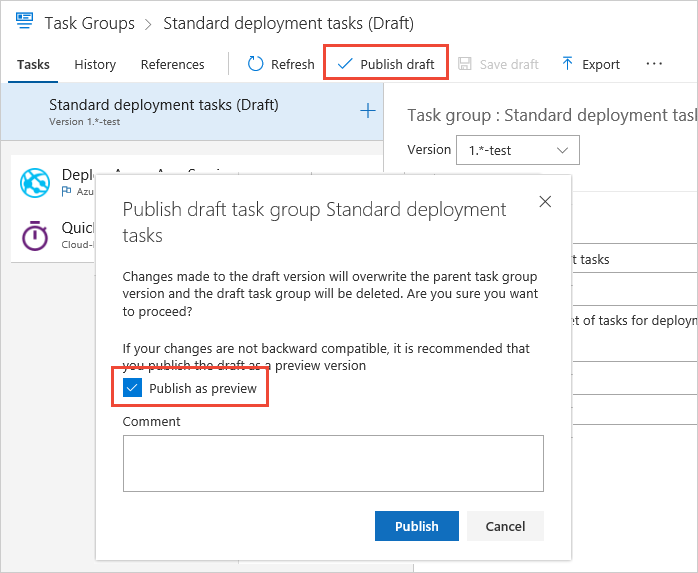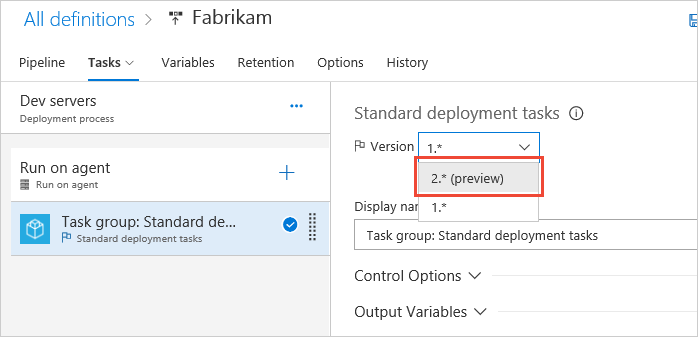Task groups for builds and releases (classic)
TFS 2018
Note
Microsoft Visual Studio Team Foundation Server 2018 and earlier versions have the following differences in naming:
- Pipelines for build and release are called definitions
- Runs are called builds
- Service connections are called service endpoints
- Stages are called environments
- Jobs are called phases
A task group allows you to encapsulate a sequence of tasks, already defined in a build or a release pipeline, into a single reusable task that can be added to a build or release pipeline, just like any other task. You can choose to extract the parameters from the encapsulated tasks as configuration variables, and abstract the rest of the task information.
The new task group is automatically added to the task catalog, ready to be added to other release and build pipelines. Task groups are stored at the project level, and are not accessible outside the project scope.
Task groups are a way to standardize and centrally manage deployment steps for all your applications. When you include a task group in your definitions, and then make a change centrally to the task group, the change is automatically reflected in all the definitions that use the task group. There is no need to change each one individually.
Before you create a task group...
Ensure that all of the tasks you want to include in a task group have their parameters defined as variables, such as $(MyVariable), where you want to be able to configure these parameters when you use the task group. Variables used in the tasks are automatically extracted and converted into parameters for the task group. Values of these configuration variables will be converted into default values for the task group.
If you specify a value (instead of a variable) for a parameter, that value becomes a fixed parameter value and cannot be exposed as a parameter to the task group.
Parameters of the encapsulated tasks for which you specified a value (instead of a variable), or you didn't provide a value for, are not configurable in the task group when added to a build or release pipeline.
Task conditions (such as "Run this task only when a previous task has failed" for a PowerShell Script task) can be configured in a task group and these settings are persisted with the task group.
When you save the task group, you can provide a name and a description for the new task group, and select a category where you want it to appear in the Task catalog dialog. You can also change the default values for each of the parameters.
When you queue a build or a release, the encapsulated tasks are extracted and the values you entered for the task group parameters are applied to the tasks.
Changes you make to a task group are reflected in every instance of the task group.
Create a task group
Ensure that all the tasks you intend to include do not contain any linked parameters. The easy way to do this is to choose Unlink all in the settings panel for the entire process.

Select a sequence of tasks in a build or release pipeline, open the shortcut menu, and then choose Create task group.

Specify a name and description for the new task group, and the category (tab in the Add tasks panel) you want to add it to.
After you choose Create, the new task group is created and replaces the selected tasks in your pipeline.
All the '$(vars)' from the underlying tasks, excluding the predefined variables, will surface as the mandatory parameters for the newly created task group.
For example, let's say you have a task input $(foobar), which you don't intend to parameterize. However, when you create a task group, the task input is converted into task group parameter 'foobar'. Now, you can provide the default value for the task group parameter 'foobar' as $(foobar). This ensures that at runtime, the expanded task gets the same input it's intended to.
Save your updated pipeline.
Manage task groups
All the task groups you create in the current project are listed in the Task Groups page of Azure Pipelines.

Use the Export shortcut command to save a copy of the task group as a JSON pipeline, and the Import icon to import previously saved task group definitions. Use this feature to transfer task groups between projects and enterprises, or replicate and save copies of your task groups.
Select a task group name to open the details page.

- In the Tasks page you can edit the tasks that make up the task group. For each encapsulated task you can change the parameter values for the non-variable parameters, edit the existing parameter variables, or convert parameter values to and from variables. When you save the changes, all definitions that use this task group will pick up the changes.
All the variable parameters of the task group will show up as mandatory parameters in the pipeline definition. You can also set the default value for the task group parameters.
In the History tab you can see the history of changes to the group.
In the References tab you can expand lists of all the build and release pipelines, and other task groups, that use (reference) this task group. This is useful to ensure changes do not have unexpected effects on other processes.
Create previews and updated versions of task groups
All of the built-in tasks in Azure Pipelines and TFS are versioned. This allows build and release pipelines to continue to use the existing version of a task while new versions are developed, tested, and released. In Azure Pipelines, you can version your own custom task groups so that they behave in the same way and provide the same advantages.
After you finish editing a task group, choose Save as draft instead of Save.

The string -test is appended to the task group version number. When you are happy with the changes, choose Publish draft. You can choose whether to publish it as a preview or as a production-ready version.

You can now use the updated task group in your build and release processes; either by changing the version number of the task group in an existing pipeline or by adding it from the Add tasks panel.

As with the built-in tasks, the default when you add a task group is the highest non-preview version.
After you have finished testing the updated task group, choose Publish preview. The Preview string is removed from the version number string. It will now appear in definitions as a "production-ready" version.

In a build or release pipeline that already contains this task group, you can now select the new "production-ready" version. When you add the task group from the Add tasks panel, it automatically selects the new "production-ready" version.

Working with task group versions
Any task group update can be a minor or major version update.
Minor version
Action: You directly save the task group after edit instead of saving it as draft.
Effect: The version number doesn’t change. Let’s say you have a task group of version 1.0. You can have any number of minor version updates i.e. 1.1, 1.2, 1.3 etc. In your pipeline, the task group version shows as 1.* The latest changes will show up in the pipeline definition automatically.
Reason: This is supposed to be a small change in the task group and you expect the pipelines to use this new change without editing the version in the pipeline definition.
Major version
Action: You save the task group as draft and then create a preview, validate the task group and then publish the preview as a major version.
Effect: The task group bumps up to a new version. Let’s say you have a task group of version 1.*. A new version gets published as 2.*, 3.*, 4.* etc. And a notification about availability of new version shows up in all the pipeline definitions where this task group is used. User has to explicitly update to new version of the task group in pipelines.
Reason: When you have a substantial change which might break the existing pipelines, you would like to test it out and roll out as a new version. Users can choose to upgrade to new version or choose to stay on the same version. This functionality is same as a normal task version update.
However, if your task group update is not a breaking change but you would like to validate first and then enforce pipelines to consume the latest changes, you can follow below steps.
- Update the task group with your desired changes and save it as a draft. A new draft task group ‘<Taskgroupname>-Draft’ will be created which contains the changes you have done. And this draft task group is accessible for you to consume in your pipelines.
- Now, instead of publishing as preview, you can directly consume this draft task group in your test pipeline.
- Validate this new draft task group in your test pipeline and once you are confident, go back to your main task group and do the same changes and save it directly. This will be taken as minor version update.
- The new changes will now show up in all the pipelines where this task group is used.
- Now you can delete your draft task group.
Related topics
Help and support
- Explore troubleshooting tips.
- Get advice on Stack Overflow.
- Post your questions, search for answers, or suggest a feature in the Azure DevOps Developer Community.
- Get support for Azure DevOps.